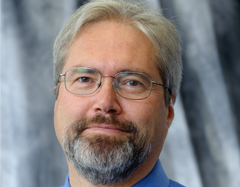October 12, 2015
 David Williams has a vision: to develop technologies that will help understand how we see and assist in curing blinding eye disease. For his progress so far, he receives Sigma Xi’s William Procter Prize for Scientific Achievement on October 24 at the Annual Meeting and Student Research Conference.
David Williams has a vision: to develop technologies that will help understand how we see and assist in curing blinding eye disease. For his progress so far, he receives Sigma Xi’s William Procter Prize for Scientific Achievement on October 24 at the Annual Meeting and Student Research Conference.
Your research in human vision is incorporating technology from astronomy. How so?
When astronomers are trying to look up at the stars through their telescopes, they use a technology called adaptive optics. I realized I could take that same technology, modify it slightly, and not correct the aberrations that occur in the atmosphere, which is what plagues ground-based astronomy, but instead correct aberrations in the eye with unprecedented accuracy.
We figured out how to measure these aberrations very accurately, and we use adaptive optics technology to correct these aberrations. It allowed us to do two things. It allowed us to improve people’s vision by measuring and correcting more aberrations than what was possible before. And it allowed us to look inside the eye with much greater clarity than we’ve ever been able to do before. Now we can resolve single cells in the back of the eye with the special kinds of ophthalmoscopes that we’ve been developing over the last two decades.
What impact is this having in correcting vision problems?
Essentially, everybody who has LASIK these days, whether they know it or not, is using this wavefront sensor that we helped to develop, or a variant of it, in order to improve the outcome. This technology has improved the design of contact lenses and it’s also used for intraocular lenses [artificial lenses used when cataracts form] … even spectacles, to some extent, are being improved.
On the other hand, if we’re looking into the eye with an ophthalmoscope that’s equipped with adaptive optics, we use a mirror called a deformable mirror. We use the aberration measurements to adjust the shape of that mirror in just the right way so as to correct the aberrations. Once you have a deformable mirror in your instrument for taking pictures of the back of the eye, you can collect a microscopic view because you no longer have the blur that is normally present when you look into somebody’s eyes.
What are you working on now?
We have been working for almost two decades to develop improved cameras that use adaptive optics to take pictures of the inside of the eye. By combining a technology called optical coherence tomography with adaptive optics, you get an improvement in resolution in all three special dimensions and that allows you to see the three-dimensional volume of the retina. At University of Rochester, we’ve been combining adaptive optics with fluorescence imaging so we have the opportunity to study the retina in a novel way. Also, we and our collaborators around the country have been working over about a 10-year period to develop new methods to stabilize the image so we can freeze eye motion and capture even sharper images.
What are the ultimate goals of your research?
We would like to understand why the retina is organized the way it is. The second aspect of our research program will be working more closely on using this technology to improve cures for eye disease. Thanks to molecular biology, there are a host of new technologies on the horizon that are not yet ready for human use but that are under development. I think in the next decade or two we’ll produce major inroads in our ability to cure blinding eye disease, especially diseases that affect the outer retina—diseases that damage the rods and cones like macular degeneration.
We’re positioning our adaptive optics camera to accelerate the development of those technologies. These diseases kill cells, and if you’re going to rapidly determine what works and doesn’t work in the way of therapy, you need to be able to view those cells in living eyes. Our group at Rochester has a partnership with three other institutions: an investigator at Harvard and University of Wisconsin and also in Basel, Switzerland. We’re working on three different approaches to curing blinding eye disease of the retina, using our high-resolution camera.
To watch the full interview with David Williams, visit his award page.
Photo: David Williams is University of Rochester’s dean for research in the School of Arts, Sciences and Engineering, the William G. Allyn Professor of Medical Optics, and director of the Center for Visual Science. (Image courtesy of David Williams.)